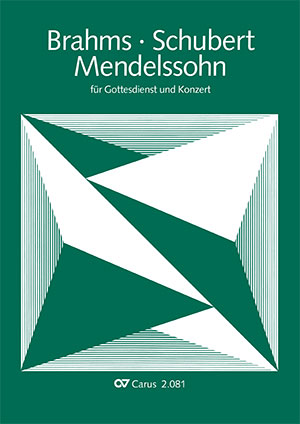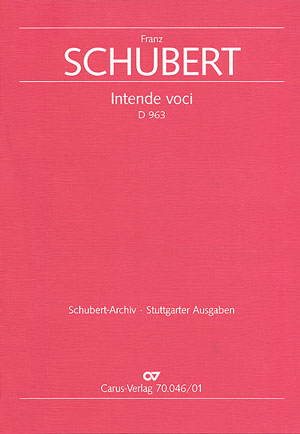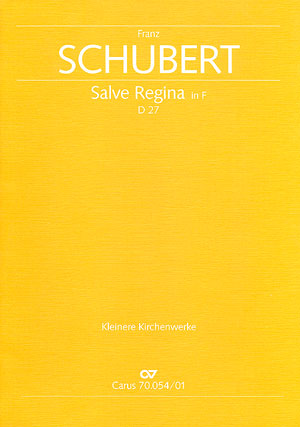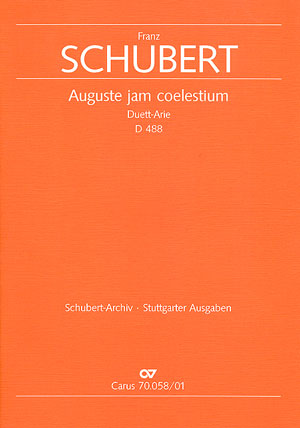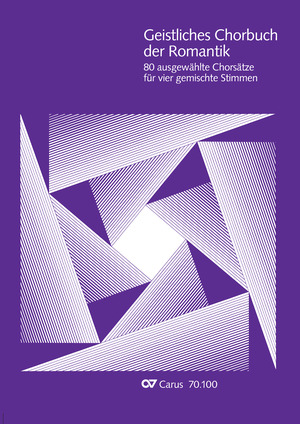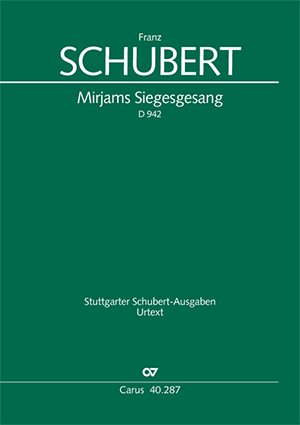
Mirjams Siegesgesang
D 942, 1828
-
Composer
Franz Schubert
| 1797-1828Throughout most of his life Franz Schubert was concerned with church music. When he was eleven he was chosen as treble soloist at his local church in the Vienna suburb of Lichtenthal and soon afterwards he was admitted to the choir of the Imperial Court Chapel, directed by Antonio Salieri. Soon he also began to compose; his earliest surviving sacred pieces date from 1812. During his lifetime his church music achieved a comparatively wide degree of acceptance but after his death, most notably, his smaller works were unjustly forgotten. The Carus programme encompasses Schubert’s complete sacred compositions and it is intended to emphasize the wide range of his works in this area. Many of the smaller liturgical compositions are published here for the first time in separate editions. What is to be discovered is a fascinating œuvre, rooted in the ‘stile antico’ of Antonio Salieri and in the compositions of the Viennese classical masters, but whose exquisite lyricism and harmonic subtlety reveal a typically Schubertian world of expression: works with great power of conviction and exceptional musical beauty. Personal details
-
Editor
Salome Reiser
| 1965-2014
Reviews
Schubert Franz: Mirjams Siegesgesang
Schubert Franz: Mirjams Siegesgesang
In seinem letzten Lebensjahr hat Franz Schubert u. a. auch zwei Texte Franz Grillparzers vertont: das Ständchen D 921 und Mirjams Siegesgesang D 942 für Solo-Sopran, vierstimmigen gemischten Chor und Klavier. Die teilweise historisierende Kompositionstechnik könnte aus einer späten Beschäftigung Schuberts mit dem Werk Georg Friedrich Händels herrühren. Zusammen mit der alttestamentarischen Thematik (2. Mose 1S, 20-21) und der dramatischen Anlage verleiht sie jedenfalls dieser Kantate einen heroischen Ton, der absolut untypisch ist für den „späten Schubert”, wie wir ihn z. B. aus der C-Dur-Sinfonie, der Es-Dur-Messe oder dem großartigen Streichquintett in C kennen und schätzen. Den Plan, Miriams Siegesgesang zu orchestrieren, konnte Schubert nicht mehr realisieren. Im Rahmen eines Gedächtniskonzerts, das im Januar 1829 für Schubert veranstaltet wurde, erlebte die Komposition erst posthum ihre Uraufführung. In den damaligen Rezensionen wurde das Werk gerühmt. Es verbinde den „kräftigen Ernst eines Händel mit Beethovens Feuergeiste” und erinnere „ohne nachgeahmt zu seyn, an die Erhabenheit der Händel’schen Compositionen”. Nun ja, so kann man das auch sehen. Die Ausgabe (Herausgeberin: Salome Reiser) ist ohne Fehl und Tadel. Aufführungsdauer ca. 18 min., mittelschwer, aber nur für anspruchsvollere Chöre empfehlenswert
Siegfried Bauer
Quelle: Württembergische Blätter 3/99, 66 Jahrgang, S. 28
Franz Schubert: Mirjams Siegesgesang D 942
Diese späte Kantate aus Schuberts Todesjahr ist ein interessantes, spannendes Stück Musik. Der Chorpart präsentiert sich überwiegend homophon, unterbrochen von zeitweiligen imitatorischen Abschnitten. Den eindrucksvollen Abschluss bildet eine groß angelegte Fuge. Die Solopartie ist nicht sonderlich schwierig. Nur das c’” sollte (kurzfristig aber überzeugend) zur Verfügung stehen. Auch die Chorteile sind weitgehend unproblematisch zu bewältigen, vorausgesetzt, dass der Chor sicher intonieren und die der Musik innenwohnende Dramatik in Klang umsetzen kann. Der Preisgesang der Mirjam -Schwester von Moses und Aaron - bezieht sich auf die Errettung Israels vor den Ägyptern beim schadlosen Durchzug durchs rote Meer Das Klangbild ist vom „Kriegston” (Punktierte Motive) und nach Größe strebender Erhabenheit bestimmt. Offensichtlich hatte Schubert selbst an eine Orchestrierung des effektvollen Stückes gedacht. Franz Lachner hat sie nachträglich ausgeführt. Der Klavierpart ist nicht übermäßig schwer, verlangt aber doch den versierten Spieler. Dem Stück ist häufigere Aufführung als bisher zu wünschen, erst recht aus dieser sehr befriedigenden Ausgabe!
Quelle: Kirchenmusik im Bistum Limburg 2/2000, S. 38/39
Frequent questions about this work
 There are no questions and answers available so far or you were unable to find an answer to your specific question about this work? Then click here and send your specific questions to our Customer Services!
There are no questions and answers available so far or you were unable to find an answer to your specific question about this work? Then click here and send your specific questions to our Customer Services!





